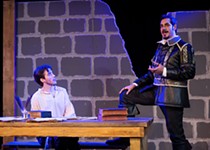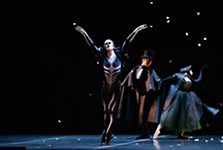Exhibitionism
Fri., Nov. 13, 1998
Parking lot of Mother's Cafe,
October 25
 "Only in Austin," said a man watching from the bus stop on the other side of Duval. Perhaps. Austin, or New York, or Paris, or San Francisco. But true enough that Dan Lovell's posture-less Sunday brunch performance in the parking lot of Mother's Cafe at 43rd and Duval Streets seemed like one of the inspirationally directionless moments in Slacker. Or should I say Stacker?
"Only in Austin," said a man watching from the bus stop on the other side of Duval. Perhaps. Austin, or New York, or Paris, or San Francisco. But true enough that Dan Lovell's posture-less Sunday brunch performance in the parking lot of Mother's Cafe at 43rd and Duval Streets seemed like one of the inspirationally directionless moments in Slacker. Or should I say Stacker?
For ostensibly no reason, Lovell pulled into the Mother's parking lot around 9am on Sunday, October 25, unloaded five chairs from the trunk of his car, and began wrestling them into a vertical stack. As brunchers milled about among Julio's, Mother's, Quackenbush's, and Fresh-Plus, all quietly kept an eye on Lovell's chairs. Lovell constantly rearranged the stack of precariously interlocked office chairs turned upside down on kitchen chairs for optimum balance like some kind of masochistic game of Jenga. He seemed not to notice the growing crowd behind him, as he successfully added each new chair to his tower and then gleefully ran to his camera to photograph the opus.
Was he protesting something? Although the parking lot had been empty when he drove up, it was nearly full now and Lovell's experiment was becoming a nuisance. Nobody stopped him, however, or even interrupted his concentration to ask what he was doing. Instead, a growing crowd of people began silently rooting for Lovell's triumph over gravity and holding their collective breath.
When Lovell delicately placed the final angel on his Christmas tree of chairs, there was a smattering of applause immediately followed by what appeared to be the orchestrated finale: the doors of Mother's opening for business. It seemed the perfect pre-brunch diversion, but Lovell says he didn't mean it as a performance at all; he was simply photographing the chairs to use in a stop-action animation project for a class at the University of Texas. His film's topic? The unique blend of community found in Hyde Park. Only in Austin. -- Kayte VanScoy
PORGY AND BESS: OVERCOMING LIMITATIONS
Paramount Theatre,
October 29

Dallas Black Dance Theatre gave itself a difficult assignment: Take one of the most well-known American musical works of the 20th century, omit all its lyrics and dialogue, devise believable choreography for one of the main characters, who is lame in one leg, and -- last but not least -- simplify a complicated plot so that an audience unfamiliar with the story could follow the action. Considering all these restrictions, DBDT did a pretty good job with its dance version of Porgy and Bess.
The Paramount's beautiful interior lent an old-fashioned charm to the show, and the theatre's fly system accommodated the multiple drops and set pieces with little difficulty. The resulting limitations in the stage area intensified the repressive mood of the production. Bold horizontal and vertical lines dominated the decor, representing not only slats of wood and metal bars but the confines of the world inhabited by the characters. Just as Porgy could not overcome his physical limitations, his ill-fated love, Bess, could not overcome her addictions.
The Miles Davis score was dark and brooding with a few moments of levity, at times supporting the choreography but too often at odds with it, which weakened the story's dramatic impact. Costumed in street clothes and shoes of the 1930s, dancers in the exuberant group numbers performed an excellent blend of Alvin Ailey-inspired choreography and American vernacular dance. Strong mimetic skills and saucy characterizations made several soloists stand out -- particularly Isaiah Davis as the drug-dealer "Sportin' Life," whose irreverent posturing, wavy arm gestures, and snake-like movements seduced the others to join in improprieties until he was finally chased away by a knife-wielding woman with super-high kicks.
Sarita Allen, a 20-year member of the Ailey company, danced the role of Bess with full-figured sensuality and maturity. Her performance ranged from bawdy and reckless to languorous and heavy-lidded as she succumbs to her drug addiction and her dangerous lover Crown. Porgy, her champion, danced by Le Von Campbell, hobbled on his crutch, wheeled himself around on a low cart, and partnered Allen in two touching duets, first supporting her from the ground, then later, in a dreamlike sequence, standing and leaping with both legs until the wistful, airy music ended and he returned to his crutch. Although this was an effective solution to the problem of a disabled lead, I would have loved to see this idea developed further, especially during the first duet, where the choreography seemed to forget that Porgy could use only one leg. It was in the second duet that I realized his transformation was deliberate and not a mistake.
All things considered, DBDT did an admirable job translating Porgy and Bess into dance. Except for the muddy ending, the plot and characterizations were clear. Transforming Porgy was an excellent choice, one that made his loss all the more poignant. Although there was no dialogue, the dancers chattered, interacted, and spoke key phrases occasionally, freeing the piece from "dancer silence" and grounding the action in reality. -- Dawn Davis
STILL LIFE: SHARP WIT AT WORK
Lyons Matrix Gallery,
through November 14
It's lucky for us that Tre Arenz exhibits her work every now and then. That way, we can make sure that our pursuit of good art in Austin doesn't get too serious. Arenz's work brings to mind Duchamp and his urinal or Rauschenberg and his goat, but only insofar as those artists managed to inject a fresh perspective into art. For the most part, the ribald and shock-tactic approaches of Duchamp and Rauschenberg were far too offensive for what Arenz accomplishes. Instead, her crafted ceramic sculpture lets us know there's still room for a new perspective that's playful and intelligent without having to stuff it down our throats. In short, she does it with subtlety.
If you didn't know this as you walk down the sidewalk in front of the Lyons Matrix Gallery and notice behind the picture window a large golden dog resting on a pedestal with its feet sticking in the air, you might think it odd for an artist to install a sculpture of a dead golden dog in the window of a gallery. When you find out that the name of the show it's representing is "Still Life," you might smirk. However, when you get a little closer and find out that the title of the piece is Idol, you'll understand that the sculpture wryly alludes to the Biblical story of the Golden Calf. With Arenz, there's always a sharp wit at work in more ways than that of a practical joker.
"Still Life" is not entirely about dead idols. Arenz has taken the classic components of still life painting -- a vessel, some food, a table surface -- and translated them into ceramic sculpture. At the same time, the objects she uses tend to be exaggerated, almost animated things like oversized wine bottles, toy airplanes, enormous fruits, and colorful hippopotami, all set on top of blue or green tables painted in black concentric circles. The result is a funny jab at the still life genre that comes off at times sublime and most always original. In Still Life Over Sea, the artist has cast a large ceramic bowl, painted it blue-green, filled it with ceramic fish and placed an orange, glazed airplane on top of the fish. Another piece titled Pink Still Life depicts a cute and cuddly pig sitting in a pink toilet bowl with a ceramic flower coming out of the back plumbing. If anything, Arenz's artwork relaxes with a smile before it punches with surprising insight.
In many ways, Arenz's "Still Life" is the work of an artist who manages to breathe new life into an artistic mainstay initially used as a Dutch painting exercise. More poignantly, however, the show is a display of original design by an artist who enjoys what she does without taking herself too seriously. It's a combination that offers enough gusto to actually create something new. -- Sam Martin








